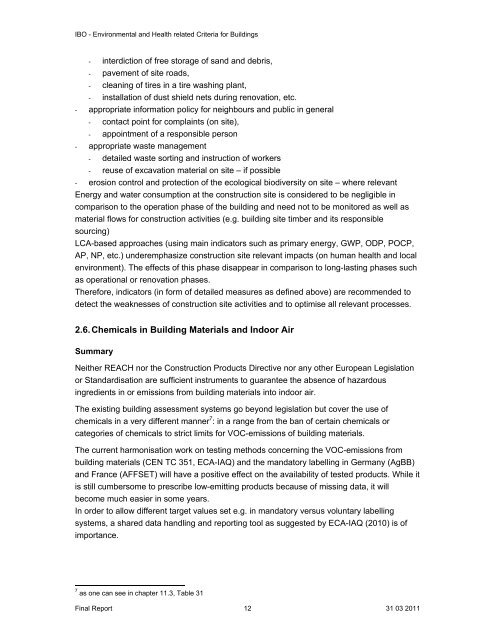Environmental and health related criteria for buildings - ANEC
Environmental and health related criteria for buildings - ANEC
Environmental and health related criteria for buildings - ANEC
Create successful ePaper yourself
Turn your PDF publications into a flip-book with our unique Google optimized e-Paper software.
IBO - <strong>Environmental</strong> <strong>and</strong> Health <strong>related</strong> Criteria <strong>for</strong> Buildings<br />
- interdiction of free storage of s<strong>and</strong> <strong>and</strong> debris,<br />
- pavement of site roads,<br />
- cleaning of tires in a tire washing plant,<br />
- installation of dust shield nets during renovation, etc.<br />
- appropriate in<strong>for</strong>mation policy <strong>for</strong> neighbours <strong>and</strong> public in general<br />
- contact point <strong>for</strong> complaints (on site),<br />
- appointment of a responsible person<br />
- appropriate waste management<br />
- detailed waste sorting <strong>and</strong> instruction of workers<br />
- reuse of excavation material on site – if possible<br />
- erosion control <strong>and</strong> protection of the ecological biodiversity on site – where relevant<br />
Energy <strong>and</strong> water consumption at the construction site is considered to be negligible in<br />
comparison to the operation phase of the building <strong>and</strong> need not to be monitored as well as<br />
material flows <strong>for</strong> construction activities (e.g. building site timber <strong>and</strong> its responsible<br />
sourcing)<br />
LCA-based approaches (using main indicators such as primary energy, GWP, ODP, POCP,<br />
AP, NP, etc.) underemphasize construction site relevant impacts (on human <strong>health</strong> <strong>and</strong> local<br />
environment). The effects of this phase disappear in comparison to long-lasting phases such<br />
as operational or renovation phases.<br />
There<strong>for</strong>e, indicators (in <strong>for</strong>m of detailed measures as defined above) are recommended to<br />
detect the weaknesses of construction site activities <strong>and</strong> to optimise all relevant processes.<br />
2.6. Chemicals in Building Materials <strong>and</strong> Indoor Air<br />
Summary<br />
Neither REACH nor the Construction Products Directive nor any other European Legislation<br />
or St<strong>and</strong>ardisation are sufficient instruments to guarantee the absence of hazardous<br />
ingredients in or emissions from building materials into indoor air.<br />
The existing building assessment systems go beyond legislation but cover the use of<br />
chemicals in a very different manner 7 : in a range from the ban of certain chemicals or<br />
categories of chemicals to strict limits <strong>for</strong> VOC-emissions of building materials.<br />
The current harmonisation work on testing methods concerning the VOC-emissions from<br />
building materials (CEN TC 351, ECA-IAQ) <strong>and</strong> the m<strong>and</strong>atory labelling in Germany (AgBB)<br />
<strong>and</strong> France (AFFSET) will have a positive effect on the availability of tested products. While it<br />
is still cumbersome to prescribe low-emitting products because of missing data, it will<br />
become much easier in some years.<br />
In order to allow different target values set e.g. in m<strong>and</strong>atory versus voluntary labelling<br />
systems, a shared data h<strong>and</strong>ling <strong>and</strong> reporting tool as suggested by ECA-IAQ (2010) is of<br />
importance.<br />
7 as one can see in chapter 11.3, Table 31<br />
Final Report 12 31 03 2011
















